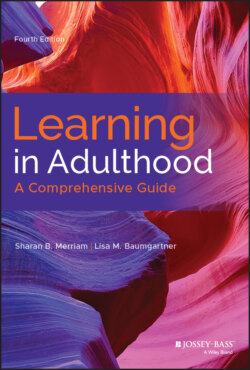Читать книгу Learning in Adulthood - Sharan B. Merriam - Страница 55
Learners Are Abstract, Not Socialized, Individuals
ОглавлениеAs we have already noted in this chapter, the predominant view of adult learner participation is through the lens of individual learners who have chosen to participate in a learning activity. Much of the discourse on participation explains nonparticipation from an individual deficit stance—that is, there is something wrong with or deficient about nonparticipants or they would be clamoring to be in our adult education programs. Further, these nonparticipants are probably most in need of what adult education has to offer.
This discourse fails to take into account the sociocultural context of adult learners and the structural characteristics of the adult education enterprise itself. Although we have addressed some of these factors in the preceding section, “Adding a Sociological Lens to Explanations of Participation,” there is more that can be said about this major misconception about participation.
The democratic ideals of equal opportunity and open access make the current reality of uneven and unequal participation in formal adult learning particularly worrisome to some policymakers, educators, and researchers. Most explanations focus on a person's stated reasons for nonparticipation, such as cost, time, transportation, and lack of confidence. When viewed from a social perspective, other explanations emerge. Rubenson (1989, p. 64) argues, for example, that “through socialization within the family, the school, and, later on, in working life, a positive disposition towards adult education becomes a part of some group's habitus but not of others.”
Those adults who have been socialized into valuing and acquiring the attitudes and skills of the middle class will be the ones to take advantage of learning opportunities. Because most providers of such opportunities are themselves middle class, little effort is expended trying to understand and provide for other populations. The modus operandi of most providers is to offer a set of activities that they assume learners will want. A response, however, is predicated on the assumptions that learners know about the program, can attend at the time it is offered, and can afford it; that the subculture of the institution is conducive to their own; and that what is offered corresponds with what they need. Rubenson (1989, p. 65) argues that “a system of adult education that implicitly takes for granted that the adult is a conscious, self-directed individual in possession of the instruments vital to making use of the available possibilities for adult education—a system that relies on self-selection to recruit the participants—will by necessity widen, not narrow, the educational and cultural gaps in society.”
There are other reasons why certain adults have more access to learning opportunities than other adults. Where one happens to live; what one's primary language is; what color, age, or sex one happens to be; what one does for a living and level of educational attainment (Boeren & Holford, 2016; Boyadjieva & Illieva-Trichkova, 2017; Patterson, 2018) all contribute to the participation pattern in adult education. Cropley (1989, p. 146) calls these factors “framework conditions,” which “are largely a function of the circumstances in which people live, especially of factors such as the values, attitudes, habits, priorities and the like of the social groups to which they belong, the economic structure of their society, even features of the education system itself.” The result is that “some individuals are more equal than others in the choices available to them” (p. 146).
By way of illustrating how these framework conditions can determine who is more likely to benefit from adult learning opportunities, where and how one lives make a difference. It is common knowledge that there is less accessibility in rural areas than in urban or suburban centers. The picture is a bit more complicated than just a rural-urban split, however. Those in small-town rural areas are better off than those living in isolated areas, and some urban centers are as impoverished as the most rural areas. Worldwide, access to learning opportunities in rural areas is a problem at all levels of education. Further, there are those who lack a geographical place altogether—migrant, transient, homeless, and refugee populations. Migrants, for example, “are the most undereducated major subgroup in the United States, with a high school dropout rate larger than that of any other group. Their mobility, their language differences, and the cultural differences experienced as they move from one community to another combine with health and nutritional problems to negatively affect school achievement. Migrant lifestyles revolve around working, moving on to find other work, and working again” (Velazquez, 1996, p. 28). For any of these geographically mobile groups, there is little more than sporadic access to education or social services.
Age is another condition that often determines who benefits from learning opportunities. Older adults not only have the lowest levels of participation in adult education generally but also receive far less training in the workplace than younger workers (Czaja & Sharit, 2016). In some settings and in other parts of the world, age in combination with gender makes for another condition affecting access. For example, in the United States, because managerial and professional workers and all nonmanual workers receive more training than manual workers—and women are underrepresented in these positions—women, and older women in particular, are much less likely to receive employer-sponsored training than are men (Stacy & To, 1994).
